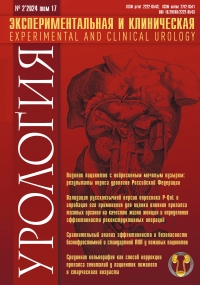Multipoint analysis of the mineral composition of staghorn stones in the study of the characteristics of their formation
 2057
2057 Introduction. Staghorn stones have a special growth pattern, in which the processes of the calculus gradually fill the internal cavities of the calyceal system of the kidney, which ultimately leads to a decrease in the function of this organ. Like other urinary stones, staghorn stones are characterized by epitaxial growth, in which one crystal layer is formed on top of the other one. The study of the metabolic bases of lithogenesis of these stones can be important for the search for new methods of antirecurrent treatment.
Aim. The purpose of this work was a comparative analysis of the mineral composition of various layers and zones of coral stones for elucidating the features of their formation and growth.
Materials and methods. To study the composition of the mineral component in 4 areas of Staghorn stones in 31 patients diagnosed with Staghorn nephrolithiasis K2-K4 (19 women and 12 men, age 31 - 75 years). 24 (77,4%) patients diagnosed with bilateral Staghorn nefro-lities, 7 (22,6%) - unilateral. Recurrent Staghorn nephrolithiasis was observed in 26 patients (83,9%), 19 patients (61,3%) patients revealed growth of microorganisms.
Results and discussion. Staghorn oxalate stones were identified in 4 patients (12.9 per cent), urinary stones - in 6 (19,4%), carbonatite - in 13 (41,9%), stru-vite - in 6 (19.4%). Cystine stone was found in 1 patient (3,2%), the stone index of urate of ammonium in 1 patient (3,2%).
The greatest accumulation of wavellite occurs in the cortical area, predla-gay to the area of the cups, (45,0 ± 15,0%), compared to the inner layers of this area (35,0 ± 11,9%, p=0,092, trend), and especially compared to the inner layers of the renal pelvis region, (32,5 ± 13,1%, p=0,015). It can be assumed that the accumulation of wavellite in the cortical layers compared to inner layers is a result of mechanisms of lithogenesis, responsible for the special nature of the growth of Staghorn calcium oxalate stones, in particular for the formation of shoots growing primarily in side of cups.
In Staghorn uric acid stones, was not observed significant differences in the distribution of anhydrous uric acid and its dihydrate forms at the outer or inner layers in areas of the cups or pelvis. Noted, however, that in the inner layers of bone region of the cups, the contents of the urate component is positively correlated with the level of excretion of uric acid (rank correlation coefficient r=0,9487, p=0,0513), and the content of uric acid in this area has a negative correlation with lead-the reason excretion of calcium (r=-0,9487, p=0,0513). This indicates a dependence of the formation of the inner layers of the Appendix urate stone Staghorn, growing in the area of the bowlcheck the intensity of the excretion of certain metabolic lithogenic factors.
The stones carbonatite, like calcium oxalate stones, one can clearly see a trend of accumulation of carbonatite in the superficial cortical layers of Staghorn stone, but more pronounced in the renal pelvis area of the stone. The contents of carbonatite in the outer cortical layers of the area of the cups was higher than in the inner layers of stone of the same field stone (78,2 ± 7,4% vs. 66,4 ± 8,2%, p=0,0182). However, in contrast to the inner layers of the renal pelvis region of the stone, (75,0 ± 6,0%), the highest accumulation of carbon-atite-TA was observed in the surface layers of stone of this region (87,7 ± 3,0%, p=0,0421), which has an inverse correlation with the indices of daily excretion of uric acid (r=- of 0,905, p=0,005) and phosphate (r=- 0,764, p=0,046).
Unlike calcium (oxalate and carbonatitic) stones struvite coallowedly concretions, on the contrary, tend to accumulate struvite in the inner layers of the stone, rather than in the surface. The content of struvite in the cortex renal pelvis of the stone (53,3 ± 16,3%) at 65-69% less (p=0,0431) than in the inner layers of the areas of this stone. Accumulation of struvite in the inner layers of stones of the renal pelvis region is positively correlated with the amount of daily excretion of uric acid (r=0,796, p=0,0321) and calcium (r=0,826; p=0,0220). However, hypercalciuria apparently is able to enhance the deposi-tion of struvite on the surface of the bone, growing in the direction of cups (r=0,9276, p=0,0077).
Conclusion. The formation of Staghorn stones of various metabolic ti- surface has its own characteristics, manifested by differences in mineral composition in different zones and layers of the stone. To a certain extent it depends on the intensity of excretion of the lithogenic substances and the presence of a urinary infection. The peculiarities of lithogenesis of the coallowing stones of different mineral compo-sition indicate the need for a special approach to the choice of therapeutic measures to prevent the growth of Staghorn stones in the course IU-trilattice, including rational antibiotic therapy and correction of existing lithogenetic metabolic disorders.
Authors declare lack of the possible conflicts of interests.
| Attachment | Size |
|---|---|
| Download | 593.14 KB |
















































































